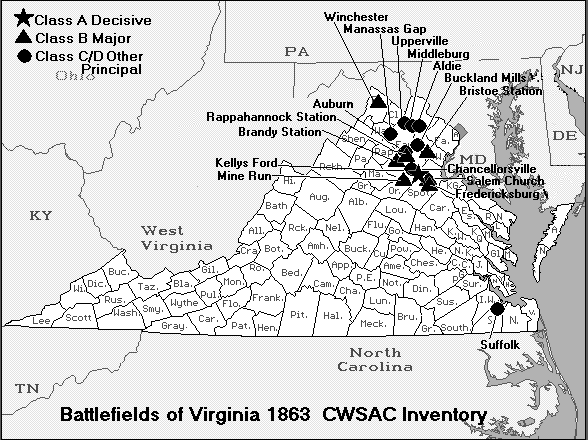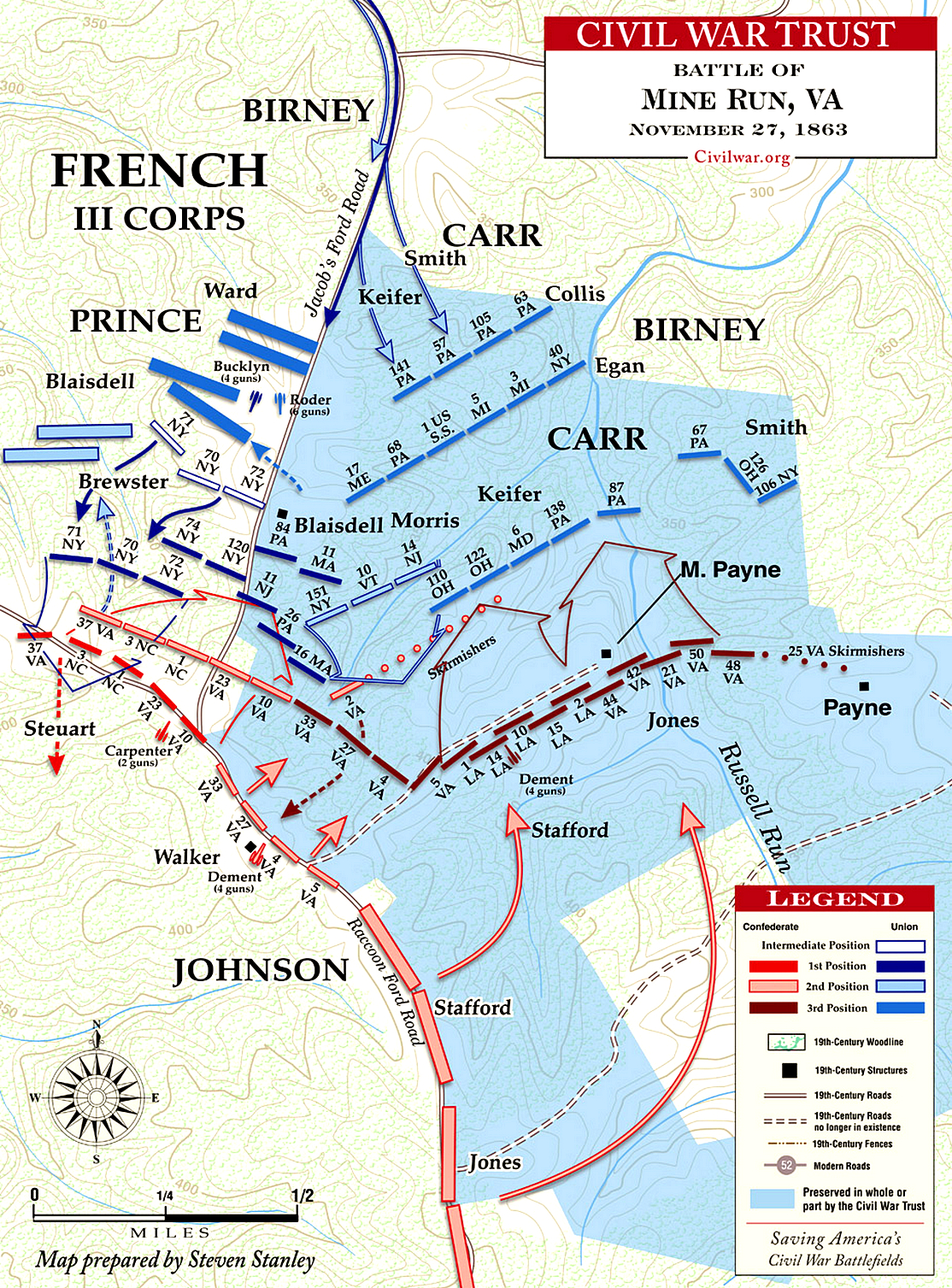|
Battle of Mine Run
Virginia Civil War History
Other Names: Payne’s Farm, New Hope Church
Location: Orange County
Campaign: Mine Run Campaign (November-December 1863)
Date(s): November
27-December 2, 1863
Principal Commanders: Maj. Gen. George Meade [US]; Gen. Robert E. Lee [CS]
Forces Engaged: Armies: 114,069 total (US 69,643; CS 44,426)
Estimated Casualties: 1,952 total (US 1,272; CS 680)
Result(s): Inconclusive
| Battle of Mine Run Map |

|
| Battle of Mine Run Battlefield Map |
Summary: Payne’s Farm and New Hope Church were the first
and heaviest clashes of the Mine Run Campaign. In late November 1863, Meade attempted to steal a march through the Wilderness
and strike the right flank of the Confederate army south of the Rapidan River. Maj. Gen. Jubal A. Early in command of
Ewell's Corps marched east on the Orange Turnpike to meet the advance of William French’s III Corps near Payne’s
Farm. Carr’s division (US) attacked twice. Johnson’s division (CS) counterattacked but was scattered by heavy
fire and broken terrain. After dark, Lee withdrew to prepared field fortifications along Mine Run. The next day the Union
army closed on the Confederate position. Skirmishing was heavy, but a major attack did not materialize. Meade concluded that
the Confederate line was too strong to attack and retired during the night of December 1-2, ending the winter campaign.
Background: After the Battle of Gettysburg in July,
Confederate Gen. Robert E. Lee and his command retreated back across the Potomac River into Virginia. Union commander Maj.
Gen. George G. Meade was widely criticized for failing to pursue aggressively and defeat Lee's army. Meade planned new offensives
in Virginia for the fall. His first attempt was a series of inconclusive duels and maneuvers in October and November known
as the Bristoe Campaign.
In late November, Meade attempted to steal a march through the Wilderness
of Spotsylvania and strike the right flank of the Confederate Army south of the Rapidan River. Meade had intelligence reports
that Lee's army, half the size of Meade's Army of the Potomac (actually 48,000 to Meade's 81,000), was split in two, separated
by Clark's Mountain, with the two flanks anchored at Mine Run and Liberty Mills, over thirty miles apart. His plan was to
cross the Rapidan at points beyond Maj. Gen. J.E.B. Stuart's cavalry screen, overwhelm the right flank (Lt. Gen. Richard S.
Ewell's Second Corps) and then follow up with the remainder (Lt. Gen. A.P. Hill's Third Corps).
| Battle of Mine Run Map |

|
| Civil War Mine Run Battlefield Map |
Unlike Maj. Gen. Joseph Hooker's plan in the Chancellorsville Campaign earlier
that year on essentially the same ground, Meade planned no diversions; he intended a lightning strike with his entire army.
The army marched on November 25 and got off to a good start, aided by fog on Clark's Mountain, which screened his movements
from Confederate lookouts. However, Maj. Gen. William H. French's III Corps got bogged down in fording the river at Jacob's
Ford, causing traffic jams when they moved their artillery to Germanna Ford, where other units were attempting to cross.
Battle: Speed had escaped Meade, who was furious
with French, and this allowed Lee time to react. Lee ordered Maj. Gen. Jubal A. Early, in temporary command of Ewell's Second
Corps, to march east on the Orange Turnpike to meet French's advance near Payne's Farm. Brig. Gen. Joseph B. Carr's division
of French's corps attacked twice. Maj. Gen. Edward "Allegheny" Johnson's division counterattacked, but was scattered by heavy
fire and broken terrain.
After dark, Lee withdrew to prepared field fortifications along Mine Run.
The next day the Union Army closed on the Confederate position. Meade planned a heavy artillery bombardment followed by Maj.
Gen. Gouverneur K. Warren's II Corps attack in the south, then Maj. Gen. John Sedgwick's VI Corps in the north an hour later.
Lee planned an assault for December 2 that would have exploited the dangling left flank of the Union line, discovered the
previous day by Maj. Gen. Wade Hampton's cavalry. Although the Union bombardment began on schedule, the major attack did not
materialize; Meade concluded that the Confederate line was too strong to attack (although Warren is credited with getting
the attack canceled) and retired during the night of December 1–2, ending the fall campaign. Lee was chagrined to find
he had no one left in his front to attack.
| Civil War Battle of Mine Run Map |

|
| Battle of Mine Run Battlefield Map |
Aftermath: The Army of the Potomac went into winter
quarters at Brandy Station, Virginia. Mine Run had been Meade's final opportunity to plan a strategic offensive prior to the
arrival of Ulysses S. Grant as general-in-chief the following spring. Lee also regretted the inconclusive results. He was
quoted as saying, "I am too old to command this army. We never should have permitted those people to get away." Confederate
hopes of repeating their Chancellorsville triumph had been dashed.
Sources: Civil War Trust, civilwar.org; Library of Congress; Eicher, David
J. The Longest Night: A Military History of the Civil War. New York: Simon & Schuster, 2001. ISBN 0-684-84944-5; Graham,
Martin F., and George F. Skoch. Mine Run: A Campaign of Lost Opportunities, October 21, 1863–May 1, 1864. Lynchburg,
VA: H. E. Howard, 1987. ISBN 978-0-930919-48-1; Esposito, Vincent J. West Point Atlas of American Wars. New York: Frederick
A. Praeger, 1959. OCLC 5890637; Salmon, John S. The Official Virginia Civil War Battlefield Guide. Mechanicsburg, PA: Stackpole
Books, 2001. ISBN 0-8117-2868-4.
|

